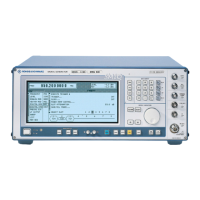SMIQ Fading Simulation
1125.5555.03 2.77 E-9
CORR PATH
Switching on or off (NONE) a correlation with the selected path. This setting is
accessible if both fading options SMIQB14 and SMIQB15 have been installed.
Only a two by two correlation of paths 1 to 6 with paths 7 to 12 can be set.
IEC/IEEE-bus command :SOUR:FSIM:PATH6:CORR:PATH 12
COEFF
Input value of the amplitude of the complex correlation coefficient. This
parameter can be coupled, see parameter COUPLED PARAMETERS...
IEC/IEEE-bus command :SOUR:FSIM:PATH6:CORR:COEF 0.5
PHASE
Input value of the phase of the complex correlation coefficient.
IEC/IEEE-bus command :SOUR:FSIM:PATH6:CORR:PHAS 180
LOGNORM STATE
Switching on or off the Log Normal-Fading.
With Log Normal-Fading set, an additional rather slow continuous changing of
the receiving amplitude of a moving receiver is simulated. Log Normal-Fading
has a multiplying effect on the path loss. The multiplication factor is time-
varying and logarithmically normally distributed. If a Rayleigh profile is set
simultaneously, this results in Suzuki-Fading.
IEC/IEEE-bus command :SOUR:FSIM:PATH6:LOGN:STAT ON
LOCAL CONST
Input value of the area constant L. This parameter can be coupled, see
parameter COUPLED PARAMETERS...
The area constant L and the speed v of the moving receiver determine the
corner frequency f
L
of Log Normal-Fading:
fvL
= /
The power density spectrum of an unmodulated carrier (CW) is an overlapping
of a discrete spectrum line at f
RF
with a frequency dependent continuous
spectrum described by
S f const e
ff
f
RF
L
()
.
=⋅
−⋅
−
æ
è
ç
ö
ø
÷
05
2
The lower limit of the range is dependent on the RF frequency f
RF
:
L
ms
f
RF
min
/
=
⋅12 10
9
IEC/IEEE-bus command :SOUR:FSIM:PATH6:LOGN:LCON 150
STD DEV
Input value of the standard deviation of the Log Normal-Fading. This
parameter can be coupled, see parameter COUPLED PARAMETERS...
IEC/IEEE-bus command :SOUR:FSIM:PATH6:LOGN:CSTD 6

